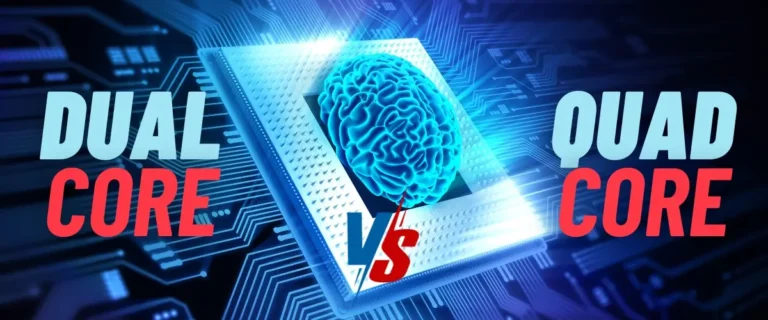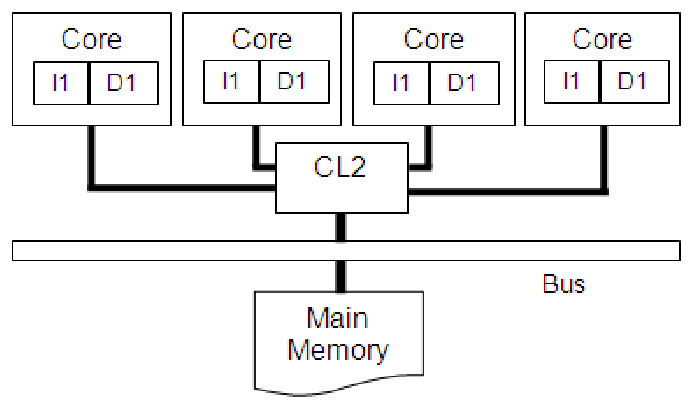In today’s rapidly advancing digital age, the heart of any computer – the processor – plays a pivotal role in defining its capabilities. The debate between dual-core and quad-core processors is more than just a technical dilemma; it’s about aligning your computing needs with the right hardware. This comprehensive guide delves into the intricacies of these two popular processor types, helping you unravel the complexities and make an informed decision for your computing needs.

Comparing Dual-Core and Quad-Core
Dual-Core
Quad-Core
| The processor chip has two cores. | The processor chip has four cores. |
| In a system with same specs, dual-core processor delivers slower clock speed and firepower than a quad-core processor. | A quad-core processor is faster and has more computing power. |
| It is energy-efficient as it uses up less battery power than a quad-core CPU. | A quad-core CPU uses up more energy due to enhanced computing output. |
| It does not deliver parallel processing performance. | It can deliver parallel processing performance. |
| There is very little chance of over-heating. | There is a high chance of the system getting overheated. |
| Not recommended for intensive tasks like video editing and gaming. | A quad-core CPU can easily handle heavy-duty tasks such as professional video editing and gaming. |
- Performance Evaluation: Dual-core processors are sufficient for regular tasks and applications that do not require intense processing power. On the other hand, quad-core processors shine in scenarios where multitasking and high-end software are the norms. Their ability to handle several tasks simultaneously without lag is a significant advantage.
- Energy and Heat Dynamics: Quad-core CPUs, with their superior capabilities, tend to consume more energy and generate more heat, which might necessitate additional cooling solutions. This aspect is crucial in environments where processors are expected to run at full capacity for extended periods.
In-Depth Technical Specifications and Comparison
Dual-Core vs Quad-Core: A Closer Look at Architecture and Performance
Architecture and Design Nuances: While both dual-core and quad-core processors operate under the same fundamental principles, the key difference lies in their core count. Dual-core processors feature two cores, allowing them to handle multiple tasks simultaneously, albeit with some limitations. In contrast, quad-core processors, equipped with four cores, excel in multitasking and can process complex operations with greater efficiency.
Recent Processor Models: A Comparative Overview
Intel’s Core i3-10100, a recent dual-core processor, stands out for its balance of efficiency and performance in everyday tasks. On the other hand, the quad-core Intel Core i5-10400F exemplifies enhanced capabilities in handling demanding applications like 3D rendering and advanced computations.


Dual-Core Efficiency: Balancing Performance and Energy
Dual-core processors, encapsulating two cores in a single chip, strike a perfect balance between performance and energy efficiency. Ideal for everyday computing, these processors offer a cost-effective solution for users with moderate computing needs.
Understanding Dual-Core Processors
- Architecture and Design: A dual-core processor is essentially a single chip containing two independent units, or cores, that read and execute program instructions. The design is akin to having two brains in one body, allowing the processor to handle multiple tasks more efficiently than a single-core processor.
- Efficiency and Energy Consumption: Due to their simpler architecture, dual-core processors typically consume less power, which translates to longer battery life in laptops and less energy consumption in desktops. This efficiency makes them a practical choice for regular office work, web browsing, and media consumption.
The Efficiency of Dual-Core Processors: Analyzing the Pros and Cons
Dual-core processors, with their two cores, strike a balance between performance and energy efficiency. These processors are less likely to overheat and are more suited for basic computing tasks like web browsing, media consumption, and office work, where high power isn’t essential.
Pros and Cons of and Dual-Core Processors
Pros
- Good performance
- Energy-efficient
- Does not overheat
- Affordable
Cons
- Cannot handle heavier workloads
- Less multitasking capacity
- Parallel processing not available
- Delivers slower clock speeds
The Power of Quad-Core Processors: Enhanced Performance and Capabilities
Quad-core processors, featuring four independent units called cores, are designed for more demanding tasks. They provide better multitasking performance and are suited for intensive applications like video editing, gaming, and heavy data processing.
Delving into Quad-Core Processors
- Advanced Computing Power: The quad-core processor, with its four cores, excels at executing multiple tasks simultaneously. This setup is particularly beneficial for software that’s designed to take advantage of multiple cores, such as video editing tools, complex games, and data-heavy programs.
- Handling Intensive Tasks: These processors can manage more intensive computational tasks with ease. They’re particularly adept at handling tasks that involve graphics, such as 3D rendering or high-resolution video processing, making them a go-to choice for professionals in creative fields.
Quad-Core Processors: Unleashing High Power and Performance
Quad-core processors provide even better multitasking performance compared to single or dual cores, making them the preferred choice for power-intensive tasks. Their ability to handle demanding software and complex multitasking comes with the trade-off of higher energy consumption and a greater risk of overheating.
Pros and Cons of Quad-Core Processors
Pros
- Excellent computing performance
- Fast clock speed
- Increased multitasking ability
- It can handle heavy tasks easily.
Cons
- Uses up a lot of energy.
- System heats up very quickly.
- Quad-core processors are usually expensive.
The Impact on Gaming and Multimedia
- Gaming: In the gaming world, the processor can make or break the experience. Games that are graphic-intensive and feature complex environments benefit greatly from a quad-core processor. The additional cores allow for smoother gameplay, better graphics, and faster frame rates.
- Multimedia Creation and Editing: For multimedia professionals, quad-core processors offer the necessary power to run heavy editing software, manage large files, and render high-quality outputs efficiently. This capability is vital for videographers, graphic designers, and animators who rely on quick processing times and multitasking.
Core Considerations: Understanding Processor Capabilities
Understanding the capabilities of dual-core and quad-core processors is crucial. While dual-core processors are known for their efficiency, quad-core processors offer advanced power and performance, suitable for software that requires more processing strength.
Expert Citations and Studies
Insights from Technology Analysts and Studies
A 2008 study by Gepner, Fraser, and Kowalik from Intel Corporation, detailed in a Springer publication, highlights the efficiency gains of quad-core processors over dual-core ones, especially in high-performance computing. Focusing on Intel Xeon processors, the study shows these quad-core processors excel in handling complex, multi-threaded tasks and offer significant power savings, pointing towards a trend of more energy-efficient and powerful computing solutions.
For a detailed understanding of this study, you can refer to the Springer publication here.
Real-World Application Scenarios
For basic computing tasks such as web browsing or document editing, a dual-core processor like Intel’s Core i3 is more than sufficient. However, for more demanding activities like gaming or video editing, a quad-core processor like AMD’s Ryzen 5 offers the necessary computational strength.
A Guide to Choosing the Right Processor
When deciding between a dual-core and a quad-core processor, consider the nature of your computing tasks. For high-end gaming or professional video editing, a quad-core processor is essential. Conversely, for everyday tasks and applications where energy efficiency is a priority, a dual-core processor is a smart, cost-effective choice.
FAQs
The number of cores is not the only determinant of CPU performance. Other factors like clock speed, software optimization, and thread count also play significant roles.
Depending on your computing requirements, a dual-core processor may suffice for basic tasks. However, for more intensive activities, a quad-core processor is recommended for its enhanced performance.
The number of cores in a processor influences its performance, with quad-core processors generally offering more power and speed compared to dual-core variants.
Quad-core processors generally command a higher price due to their enhanced capabilities, but the final cost depends on the specific model and its features.


